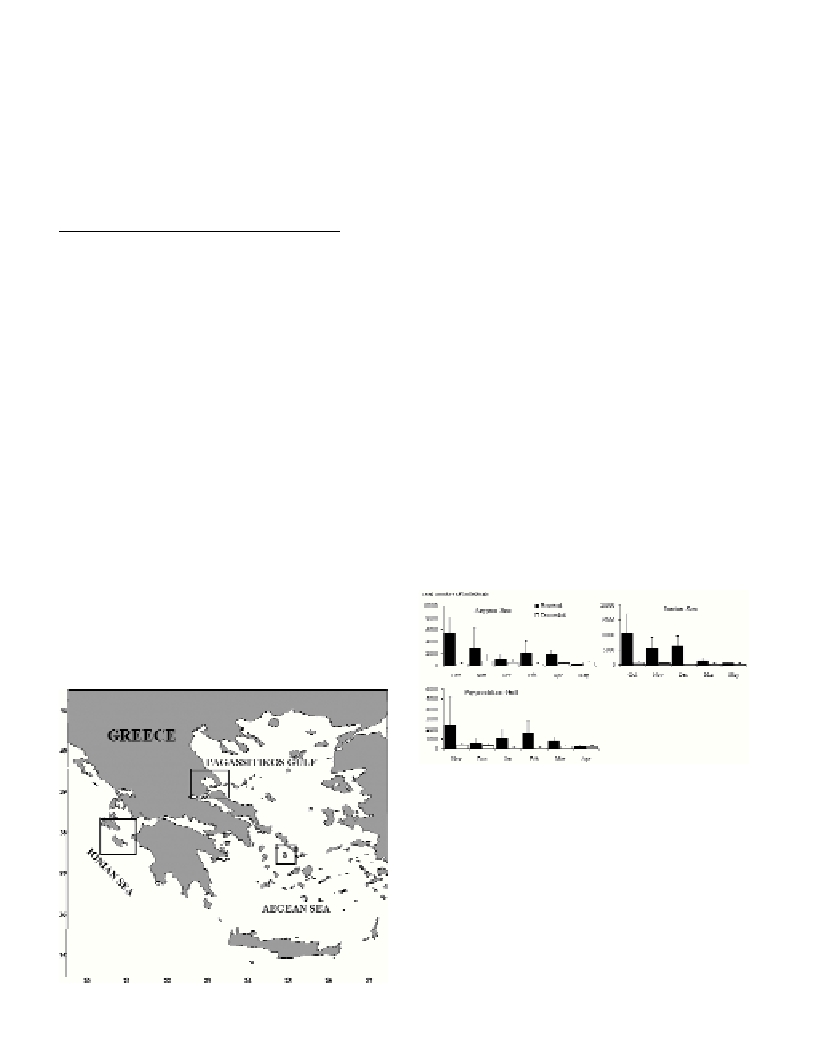RETAINED AND DISCARDED CATCHES FROM COMMERCIAL BOAT SEINES IN GREEK WATERS
George Petrakis *, Anna Chilari and Stefanos Kavadas
National Centre for Marine Research, Hellinikon, Athens, Greece - * gpetr@ncmr.gr
Abstract
Observer-based estimates of the quantities of discarded and retained catches from the commercial boat seine in Greek waters are presented.
A total of 112 species were identified in catches sampled between October 2000 and May 2001 in three areas (Ionian Sea, Cyclades
Islands, Pagassitikos Gulf). The catch composition varied significantly between the areas. The most abundant commercial species were
bogue (Boops boops), pilchard (Sardina pilchardus), picarel (Spicara smaris), common squid (Loligo vulgaris), blotched picarel (Spicara
?exuosa) and horse mackerel (Trachurus mediterraneus). The most abundant discarded species were bogue, damselfish (Chromis chromis),
rainbow wrasse (Coris julis) and common pandora (Pagellus erythrinus).
Keywords: boat seine, catch, discards, by-catch, Greece
Rapp. Comm. int. Mer Médit., 37,2004
419
Introduction
In Greek waters the annual landings of boat seiners are estimated to
represent 5.8% and 4.5% of the annual total fisheries l production and
value, respectively. The boat seine catch is dominated mainly by
picarel (46.6%) and, to a lesser degree, by pilchard (14.1%) and bogue
(11.1%) (National Statistic Service of Greece).
Boat seines are considered to have a negative impact on stocks
since the fishing activity takes place in coastal areas in the nursery
grounds of many commercial species and in some areas the gear is
fished on Posidoniasea beds which are considered to be vulnerable to
the action of the gear (EC regulation 1626/94). There are few studies
on the impacts of this gear in Greek waters. In this study, funded by
the Greek Ministry of Agriculture, observers were used to quantify the
catches of boat seines operating in three areas in Greece and to
evaluate the impact of this fishing gear in terms of by-catch and
discards.
Materials and methods
Scientific observers accompanied commercial boat-seine crews on
17 fishing trips between October 2000 and May 2001, covering the
entire fishing period, in three regions of Greece: Ionian Sea (5 trips),
Aegean Sea-Cyclades Islands (6 trips) and Pagassitikos Gulf (6 trips)
(Fig. 1). The mesh size used was 16 mm and fishing took place in
depths 15-47 m. The total catch was sorted into the retained and
discarded components by the fishermen. The total weights and
numbers of each individual species were recorded. Mean catch rates
per haul were calculated for each month. One-factor analysis of
variance was used to test for differences between months in weights
and quantities of retained and discarded catches.
Results and discussion
A total of 112 species (94 teleosteans, 6 elasmobranchs, 11
cephalopods and 1 crustacean) distributed in 48 families were
identified in catches throughout the survey. A total of 37 families were
retained and 38 families were discarded. Only 17 families were solely
retained, 22 were solely discarded and another 27 families were both
retained and discarded.
Species were assigned a relative index of abundance according to
their mean retained and discarded catch rates per haul. Retained catch
rates of bogue, pilchard and picarel in Aegean Sea, were estimated to
be greater than 100 individuals per haul, while in the Ionian Sea, only
picarel and bogue had estimated retained catch rates greater than 100
individuals per haul. The corresponding species from Pagassitikos
Gulf were blotched picarel, horse mackerel and pilchard. Concerning
the discarded species, bogue and rainbow wrasse from the Aegean
Sea, damselfish from the Ionian Sea and common pandora from
Pagassitikos Gulf had estimated rates greater than 100 individuals per
haul.
Retained and discarded catch rates varied throughout the survey
(Fig. 2), but significant differences between months were reported
only for retained catches from the Ionian Sea (P-value = 0.0045).
Ratios of the total numbers discarded to retained were 0.19 in the
Aegean Sea, 0.07 in the Ionian Sea and 0.22 in Pagassitikos Gulf. The
estimated ratios are considered to be very low for Mediterranean
fisheries, and they are generally less than those observed for bottom
trawls (about 0.44) (1), for the sole métier (0.26), the sepia métier
(0.60) and the hake métier (0.21) in Greek waters (2).
Our results indicated that: a) the proportion of the discarded was
low and varied between areas and b) catches of juveniles of
commercial species were generally low except for common pandora
in Pagassitikos Gulf.
References
1-Machias A., Vassilopoulou V., Vatsos D., Bekas P., Kallianiotis A.,
Papaconstantinou C., and Tsimenides N., 2001. Bottom trawl discards in
the northeastern Mediterranean Sea. Fish. Res.,53: 181-195.
2-Petrakis G., 1998 (ed.). Selectivity of fixed nets in Mediterranean-
SELMED. EEC contract: 95/C/76/12, NCMR.
Fig. 1. Map of the sampling areas.
Fig. 2. Mean numbers of retained and discarded total numbers of indi-
viduals taken in each season in each sampling area.

